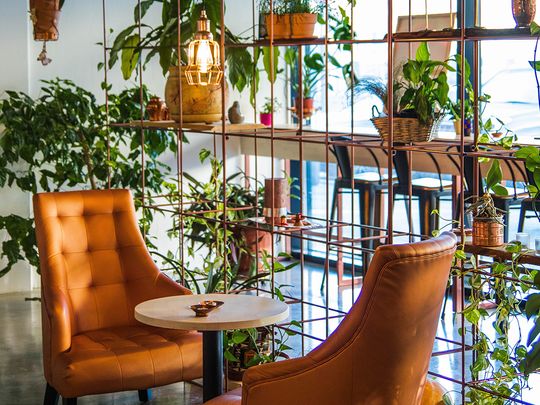
Creating a lush green paradise in your apartment almost sounds impossible. Gardening can be quite a labour-intensive task - finding the right plants and potting soil, remembering to water them and figuring what seeds to use. But indoor garden boxes and planters are the perfect solutions, and it's also easy. Indoor garden boxes are a great way to blend the indoors and outdoors. It is so much you can do with indoor gardening, for example: creating a herb garden - pluck some fresh parsley from your indoor garden to liven up your dishes. This is ideal for apartments and small spaces.
There are so many ways to incorporate them - add some succulents on a windowsill, hanging a planter, using a glass jar or a mounted planter box. The possibilities are endless.
Here’s how to create a flourishing indoor garden brimming with ferns and herbs.
Your very own DIY indoor garden box
If you’re a little apprehensive about adding an indoor garden because it might not be within your budget is understandable. You can easily do this on a budget and make it a DIY project. Some of the items are already hiding in your house.
Add a modern and trendy touch with glass jars. Convert your old glass jars into your very own personal hydroponic system. The hydroponic system ensures that your plants will get enough nutrients, oxygen and water. If you’re a beginner and don’t necessarily have a green thumb, this system is for you.
Window sill succulent garden
A succulent box made with shipping pallets serves as a quaint little corner in your home. Use a rectangular wooden box lined with plastic (use the potting soil bag) and line it with soil. Trim the edges of the plastic bag jutting out and add the succulents. Give the plants a good soak with a spray bottle and voila! You’re done.
Gulf News interviewed Darryl Cheng, the author of 'The New Plant Parent' and the creator of the House Plant Journal blog and Instagram account (@houseplantjournal), which boasts over six hundred thousand followers, says that if you do not have ample sunlight or a bright sunny window sill, adding in a grow light for a set of succulents is an alternative.
He said: “Succulents generally need a few hours of direct sun and a very large window to grow well. Since I do not have this light situation, I use a grow light for a small set of succulents on my desk - the grow light is strong and kept on for 14 hours a day.”
Living walls
Creating a vertical living plant wall is a great way to make use of limited floor and shelf space. A vertical wall planter made out of steel mesh allows you to hang plants of all sizes. Or you could mount wooden boxes on a wall, but make sure there is enough sunlight in that room. If you’re opting for something a little more hassle-free and low key, a wall pocket planter is the right choice.
Miniature indoor greenhouse
You don’t need a patio or yard to have a thriving garden with fresh herbs and veggies. Unlike growing your plants outside, an indoor greenhouse is well protected from external factors such as rain, wind and extreme heat. Create an indoor jungle with tropical houseplants in your indoor greenhouse, where you can monitor the temperature, humidity and conditions.
“Indoor greenhouses are becoming more common with the awareness of plants in your home -You should place your greenhouse where your plants could get plenty of sunlight, like next to a south-facing window or a patio door. This helps with air circulation and purification of air,” said Antara Roy, Dubai-based interior designer.
Ideally for any plant, it needs to be placed in front of ample sunlight and using natural soil that has plenty of nutrients. Most importantly is watering your plants, research how much water each plant needs and pay attention to how dry the soil is. Taking care of your plants is all about inspecting any changes and routinely checking upon them.
A portable mini garden
A terrarium is your own microscopic rainforest with a collection of small plants inside. Glass jars, fish bowls and glass containers can be used for terrariums. The terrarium has to be partially open to allow heat and light to enter to trap moisture, but also allow partial airflow.
Choosing a glass container with a wide-open on top is essential for terrariums. These can be glass jars, fish bowls, cookie jars or bell jars. Miniature plants, such as moss, succulents and ferns – come in many varieties and are ideal for low light and humid conditions.
The important rule to remember for watering succulents is only water the soil when the soil is dry.
“Succulents should be watered thoroughly only when the soil reaches 100% dryness. Do not pour a small amount of water as this will leave dry pockets where roots can die off, causing the plant to shrivel and not take in water even though you thought you watered it,” Cheng said.
A hanging garden
Hanging gardens are immensely popular among plant enthusiasts. Hanging gardens are not only practical but also provide a ‘wow’ factor to your interior decor. If you have a bright sunny window, ditch the curtains and use the curtain rod and twine to hang plants. Wall-mounted planters are easily available at most nurseries and decor shops.
“It’s no secret that in the world of home decor, indoor hanging plants are having a moment. Hanging plants help to maximise space. Here are a few hanging plants you can start with are: Devil’s Ivy, Boston Fern, Heartleaf Philodendron and Spider Plant,” she said.
Hanging planters are a whimsical and quaint way to style your apartment.
Spice up your kitchen with an indoor herb garden
Every herb garden needs a sunny windowsill, but for many indoor gardeners having enough natural light is a problem. Adding a grow light can aid in providing adequate light for your herbs. Certain herbs flourish in an indoor kitchen garden. A few examples – thyme, rosemary, parsley, chives, oregano, sage, dill, mint, basil and lavender.
A space-saving hack is to create a hanging herb garden and make use of any vertical space. Wooden pallets and boxes, old plastic bottles and jars are eco-friendly and affordable options. Macramé, the retro-chic trend is making come back and using hanging macramé planters adds an edgy and fun vibe.
You can also splurge a few bucks, and use advanced hydroponic herb kits which have built-in sensors and LED lights. Roy suggests a ‘click and grows’ garden (an indoor smart garden). This creates optimal space and storage in an apartment kitchen.
She said: “It has enough space for three plants to thrive. It's a low-maintenance herb and vegetable patch that allows you to use your green thumb year-round. Fresh basil for your pizza just got easier.”
Add colour to your home with these indoor blooming plants
You might not be able to cultivate a garden of roses in your flat, but A few flowers do blossom indoors. African violets are a popular favourite because they bloom all year round. All they need is indirect sunlight, moisture and make sure to avoid the leaves when watering.
Cheng also suggests peace lily, anthurium, and Phalaenopsis orchids. “Keep in mind that they won't always have flowers - new flowers will grow sporadically as long as the light is good,” he said. A peace lily is a great option for those who lack a green thumb because they are low maintenance.
Indirect sunlight doesn’t mean you should devoid your plants of proper sunlight. He said: “Interpreting 'bright indirect light' to mean you should avoid the direct sun entirely. Put the plant as close to the window as possible, and only if the direct sun will shine on the plant for longer than 2 or 3 hours, then you can block it with a white sheer curtain. Moving farther from the window will drastically reduce the light levels and thus, the growth potential of your houseplants.”
Basic do’s and don’ts of indoor gardening according to gardening expert, Darryl Cheng
• Maintaining moisture and humidity is essential for gardening. A thermometer or hydrometer (moisture meter) will give you the exact temperature and humidity. “A great number of houseplants will grow just fine with humidity as low as 30% as long as their light is good and you keep up with watering. I've never misted or used a humidifier,” says Cheng.
• Don't deprive your houseplants of sunlight. Cheng says that there is a common misconception that houseplants can grow indoors far from a window. This can potentially stunt their growth. “Indoors far from windows is a cave – there are no ‘cave-loving’ plants.”
• Most importantly, taking care of plants requires patience and care, and if you’re a houseplant amateur, you will make mistakes. Cheng said: “Individual leaves have limited lifespans. Don't fall into the trap of thinking ‘proper care’ will mean perfect plants forever.”
(Note: This article was first published on August 22, 2022)









